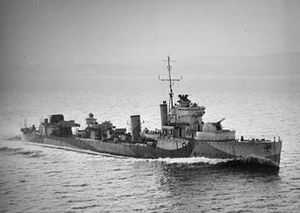HMS Verdun (L93)
 HMS Verdun underway during the Second World War | |
| Career (United Kingdom) | |
|---|---|
| Name: | HMS Verdun |
| Ordered: | 1916-17 |
| Builder: | Hawthorn Leslie and Company |
| Laid down: | 13 January 1917 |
| Launched: | 21 August 1917 |
| Commissioned: | 3 November 1917 |
| In service: | Converted to long-range escort between 1939 and 1940 |
| Fate: | Sold for scrap in April 1946 |
| General characteristics | |
| Class and type: | Admiralty V-class destroyer |
| Displacement: | 1,272-1,339 tons |
| Length: | 300 ft (91.4 m) o/a, 312 ft (95.1 m) p/p |
| Beam: | 26 ft 9 in (8.2 m) |
| Draught: | 9 ft (2.7 m) standard, 11 ft 3 in (3.4 m) deep |
| Propulsion: | 3 Yarrow type Water-tube boilers Brown-Curtis steam turbines, 2 shafts, 27,000 shp |
| Speed: | 34 kt |
| Range: | 320-370 tons oil, 3,500 nmi at 15 kt, 900 nmi at 32 kt |
| Complement: | 110 |
| Armament: |
|
| Motto: | On ne passe pas: 'They shall not pass' |
| Honours & awards: | NORTH SEA 1940-45 ARCTIC 1942 |
| Badge: | On a Field Field Paly, of three Blue, White and Red, a tower Gold. |
HMS Verdun was an Admiralty V-class destroyer of the Royal Navy which saw service in the First and Second World Wars. So far she has been the only ship of the navy to bear the name Verdun, after the Battle of Verdun. She was assigned to carry the remains of The Unknown Warrior home to Britain on 8 November 1920.
First World War
Launched on 21 August 1917 at the Hawthorn Leslie shipyard in Hebburn on Tyneside, she completed in November of the same year. She served with the Grand Fleet and the Harwich Force.[1]
The Unknown Warrior
HMS Verdun was selected to carry the Unknown Warrior across the Channel because her name would be a tribute to the French people and the endurance of their armies at Verdun in 1916. On 10 November 1920, Verdun berthed at the Quai Carnot at Boulogne-sur-Mer. The coffin of the Unknown Warrior arrived on a French military wagon in a procession of a thousand local schoolchildren and a whole division of French soldiers and marines. Marshal Foch made a speech on the dockside before the White Ensign was lowered to half mast while the coffin was carried up the gangplank and piped aboard with an admiral's salute. The coffin was laid on the quarterdeck and covered with wreaths of white flowers, some so large that it took four soldiers to lift one. Shortly before noon, Verdun moved away from the quay as sailors fired a rifle salute along with the big guns of the French forts.[2] An escort of six destroyers accompanied the Verdun through the mist to Dover where a 19-gun salute was fired from Dover Castle.[3] She tied up at Admiralty Pier where General Sir John Longley supervised the six high ranking officers from the three Armed Services who bore the coffin ashore. From Dover Marine Station the Unknown Warrior was taken by train to London for burial the following day at Westminster Abbey.[4]
Second Grand Fleet or Harwich Force
Verdun went into reserve at Rosyth as part of the 9th Destroyer Flotilla until September 1939, when she was selected for conversion into an Anti-Aircraft Escort (WAIR) at Chatham Dockyard. She was rearmed and her pennant number changed from D93 to L93 on completion in May 1940. She operated as a convoy escort out of Rosyth and in the North Sea, being damaged by a bomb on 1 November 1940 that killed 11 men, including her captain. She was repaired at Harwich and spent the rest of the war escorting convoys along the east coast. In November 1941, she was in sustained action against an attack by German E-boats; three British merchant ships were sunk in the engagement. From February to April 1942 she formed part of the escort screen for heavy units of the Home Fleet that were supporting the Arctic convoys. After the "Warship Week" National Savings campaign in March 1942, Verdun was adopted by the seaside town of Hoylake in Cheshire.[5]
Fate
HMS Verdun was placed in reserve after VE Day and then sold to be scrapped at Granton, Edinburgh in April 1946.[5] Her ship's bell now hangs on a pillar in Westminster Abbey, close to the Tomb of the Unknown Warrior.[6]
Notes
- ↑ World War 1 at Sea - SHIPS OF THE ROYAL NAVY, 1914-1919 - (Part 2 of 2): from "British Warships 1914-1919" by F J Dittmar & J J Colledge
- ↑ Hanson, Neil The Unknown Soldier Doubleday, ISBN 038560453X (Chapter 23)
- ↑ Duke of York's Royal Military School - Dukie honour guard for the Unknown Soldier
- ↑ The Dover War Memorial Project - The Unknown Warrior: A Dover Tale
- ↑ 5.0 5.1 SERVICE HISTORIES of ROYAL NAVY WARSHIPS in WORLD WAR 2 by Lt Cdr Geoffrey B Mason RN (Rtd) - HMS VERDUN (D 93) - V & W-class Destroyer
- ↑ Westminster Abbey - History - Unknown Warrior
References
- Preston, Antony (1971). 'V & W' Class Destroyers 1917-1945. London: Macdonald. OCLC 464542895.
- Raven, Alan; Roberts, John (1979). 'V' and 'W' Class Destroyers. Man o' War 2. London: Arms & Armour. ISBN 0-85368-233-X.
External links
| ||||||||||||||||||||||||||||||||||||||||||||||||||||||||||||||||||||||||